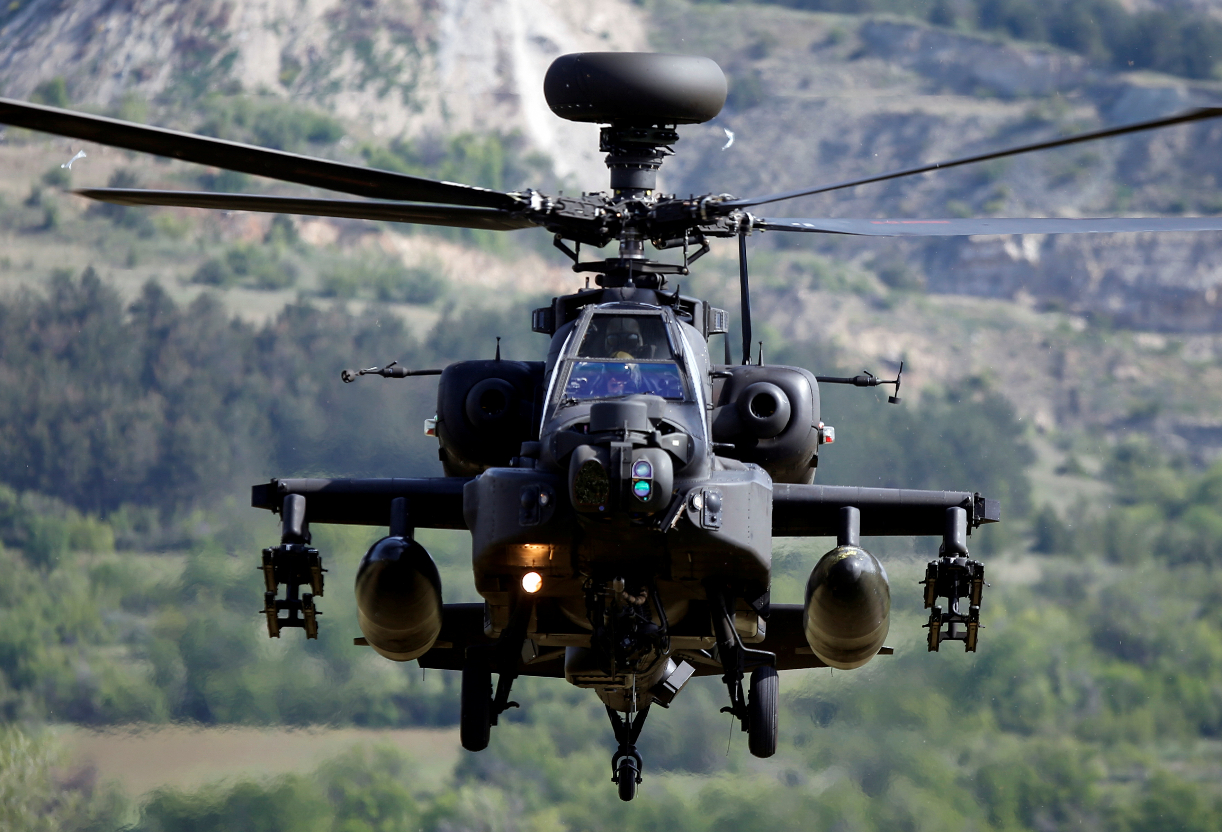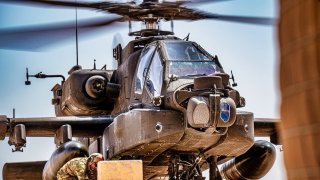The Army’s Apache AH-64E Helicopter Is A Flying Powerhouse in the Sky
The AH-64 Apache, a symbol of American airpower since its introduction in the 1980s, continues to evolve with the latest AH-64E variant. Boeing's "E" model, featuring significant upgrades like the Link 16 system, enhanced sensors, and the powerful T901 engine, ensures the Apache remains relevant on modern battlefields.
Summary and 4 Points You Need to Know: The AH-64E Apache, Boeing's latest variant of the legendary attack helicopter, offers significant upgrades, including advanced sensors, avionics, and improved target acquisition.
-Its new Link 16 open-systems architecture ensures easy future enhancements, while the General Electric T901 turbine engine boosts speed to 155 mph.
-The "E" model retains powerful offensive capabilities like the M230 30mm chain gun and Hellfire missiles, with added potential for deploying directed-energy weapons (DEW).
-Featuring state-of-the-art defensive systems, this Apache will remain a key asset for the U.S. Army well into the 2060s, supporting its role in evolving global combat scenarios.
AH-64E Apache: The Future of Army Aviation with Upgraded Sensors and Avionics
When the AH-64 Apache was introduced in the 1980s, no one could have expected its success. Decades later, the Apache is synonymous with American airpower. Indeed, it carries much of the U.S. Army’s air combat legacy.
While the Apache was originally conceived of as a multirole helicopter, it basically became a powerful attack helicopter.
This helo is so popular and ubiquitous in combat theaters across the globe that multiple variants have been built by Boeing. It’s also used by the armies of multiple allies.
The most recent and advanced Apache variant to come online is the AH-64E. Boeing’s “E” model of the Apache went under contract with the U.S. Army at the end of 2021. The “E” will “include software updates and improvements to the pilot interface,” according to the Boeing official press release.
Boeing is upgrading what’s known as the “Link 16” features of their Apache helicopter. Link 16 is described by Defense News as an “open-systems architecture that will allow for easy technology insertion later on.” In other words, Boeing is making the AH-64E model of the Apache upgradeable in ways that will ensure it makes a relevant and lethal contribution to the battlefields of today and tomorrow. Some of the other upgrades, as Defense News reports, have to do with “an optimized route and attack planning capability.”
Some Enhancements
Another feature the Pentagon is working into the new variant of the Apache is the Army’s Improved Turbine Engine built by General Electric Aerospace. This new T901 engine, coupled with drivetrain and tail rotor improvements to the new Apache, will push this bird to around 155 miles per hour (not bad for a rotor-wing aircraft). The “E” model has improved sensors as well as avionics packages.
The AH-64E has an operational ceiling of around 20,000 feet and a range of about 345 miles when fully loaded.
A further development enhances the Apache’s target acquisition and designation systems, giving the pilots of these two-seat birds a more accurate and reliable means of identifying and tracking enemy forces – at greater distances, as well.

Some staples of the Apache offensive capabilities remain on the “E” model. Its primary offensive system remains the M230 30mm chain gun, which can fire up to 625 rounds per minute. Like previous models, this bird can carry sixteen AGM-114 Hellfire missiles – these laser-guided missiles are very effective against armored targets. And like previous Apaches, the AH-64E can deploy Hydra 70 rocket pods that can be used against both soft and hardened targets.
In order to keep pace with the multipolar geopolitical environment America is entering, engineers are incorporating the ability to deploy directed-energy weapons (DEW) from the AH-64E. The US military has struggled to develop DEW for years. Advances, while slow-going, have been made, with many more to be had. The presence of pylons capable of deploying such advanced weaponry should indicate to observers that the Americans are close to having reliable and effective DEW capabilities.
Nothing Quite Like It
In terms of defenses, the “E” is equipped with state-of-the-art countermeasures to protect against enemy threats. An advanced electronic warfare suite, including radar warning receivers and infrared countermeasures, helps the AH-64E evade detection and defend against incoming missiles.
The AH-64E Apache is expected to remain in service for many years to come. With ongoing upgrades and modernization efforts, the helicopter’s capabilities are continually being enhanced to meet the evolving needs of the Army and its allies.
In fact, the Army projects that the “E” variant of the Apache attack helicopter will remain a key feature of the U.S. Army’s arsenal well into the 2060s.
Author Experience and Expertise: Brandon J. Weichert
Brandon J. Weichert, a National Interest national security analyst, is a former Congressional staffer and geopolitical analyst who is a contributor at The Washington Times, the Asia Times, and The-Pipeline. He is the author of Winning Space: How America Remains a Superpower, Biohacked: China’s Race to Control Life, and The Shadow War: Iran’s Quest for Supremacy. His next book, A Disaster of Our Own Making: How the West Lost Ukraine, is due October 22 from Encounter Books. Weichert can be followed via Twitter @WeTheBrandon.
All images are Creative Commons or Shutterstock.
From the Vault
Russia Freaked Out: Why the U.S. Navy 'Unretired' the Iowa-Class Battleships
Battleship vs. Battlecruiser: Iowa-Class vs. Russia's Kirov-Class (Who Wins?)


